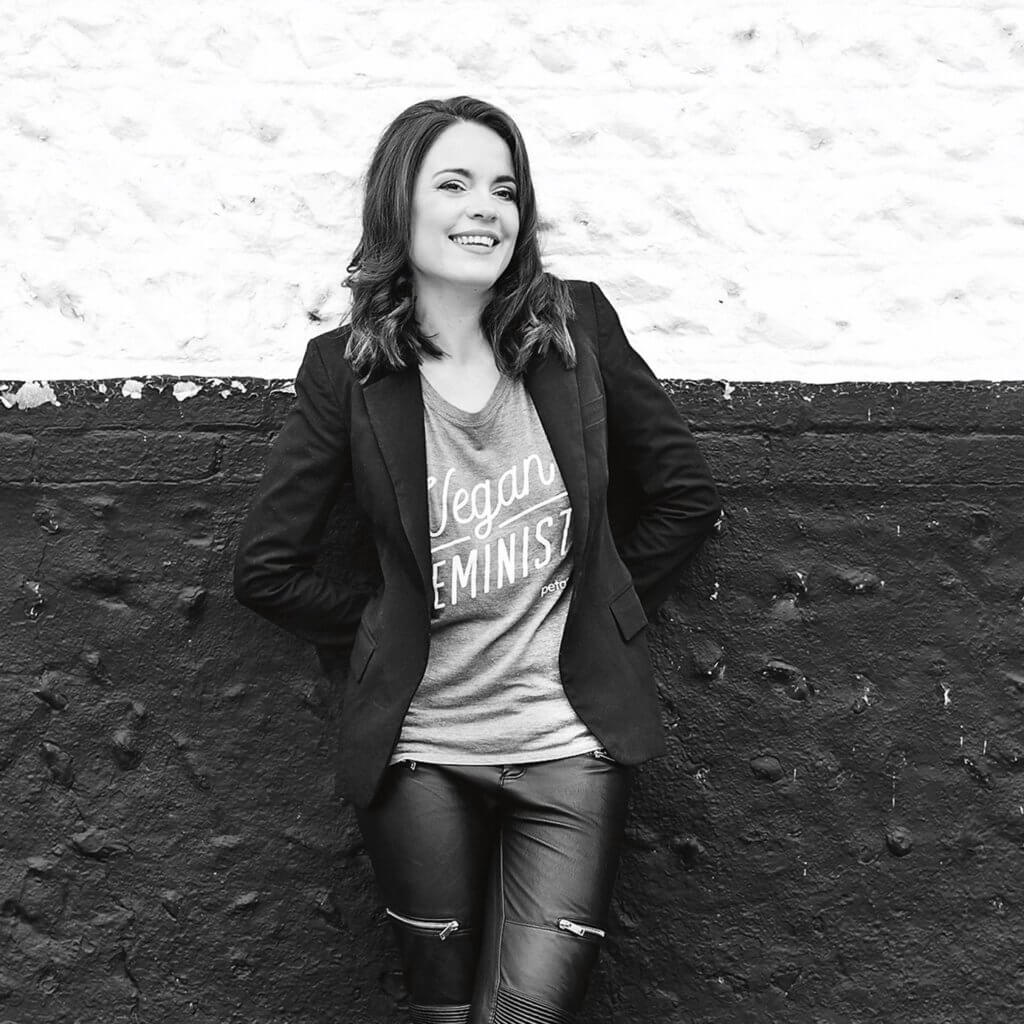
Sascha Camilli


Going vegan can be a life-changing experience, and it’s not without its challenges. The good news is you’re not alone. There are identifiable...
There’s a serum for every skin condition, but which active ingredients do what? This is the guide to vegan and sustainably sourced serums...
If you want to get your gut in order, Dr Will Bulsiewicz is the expert to help you sort out fact from fiction. This is the gut-health cheat sheet...
Mountains stretch down to coastal plains, which hug the curves of over 100 pristine beaches, all gazing out towards the stunning waters of the...
Eco period products have risen in popularity – they’re sustainable, affordable, healthy, and convenient. Here’s what you need to know so...
In the fast-paced and demanding world we live in, finding moments of stillness and calm can be challenging. In an attempt to find a little peace...
Time for an eco spring clean? Here are seven simple swaps for the conscious consumer
The creaminess of the avocado, the spiciness of the sriracha... These tacos truly are a taste sensation!
This cinnamon-scented apple loaf uses almond meal and a flax egg to create a beautiful moist sponge, which contrasts perfectly with the sliced...
A classic Italian family-style dish gets a meat-free makeover. A perfect mid-week meal in just 30 minutes!
These sweet, nutty, gluten-free crab cakes ooze with umami flavours. The cayenne pepper and sweet paprika give them the slightest kick, and...
Minestrone is a classic Italian soup that provides a delicious way to eat an abundance of vegetables in one meal. You can use any combination of...
Pulled Oumph! sure brings the flavour to this epic plant-based burger. Top with your favourite sauce and fresh veggies for the ultimate...
Jam-packed with gut-loving whole plant foods, this delicious and sustaining recipe is a perfect example of how to ‘eat the rainbow’.
Spraying sheets and pillows with calming scents can be a wonderful aid to slumber
The next time you go for a walk, discover the wonder of the everyday world around you
A skincare routine can be a way to nourish yourself inside and out
When the clouds converge, practise gratitude for the smallest of glimmers, and learn to dance in the rain.
Style yourself for success, while keeping it cruelty-free.
What makes the perfect workwear wardrobe? These days, this question comes with a whole new set of layers. Once a display of all things formal and restrained, work-appropriate attire is now a flexible enough concept to include … pyjamas (video meeting dependant, of course!). For some, workwear still means a suit, while for others it’s colourful and quirky ensembles (artsy and media types, we’re looking at you). Many have to wear a uniform, while plenty happily WFH in activewear or trackies. Today, what we wear to work is as varied as the working world itself.
So how do you approach workwear with ethics in mind? In the main, you’ll want to look at the materials being used in garments and accessories. Read the labels to ensure blazers and knits are wool free and choose accessories that are free from leather. Sustainable fabrics include eco-friendly organic cotton along with other natural fabrics, such as linen and Tencel (made from wood-pulp cellulose).
Menswear brand Brave GentleMan offers made-to-order suits in bamboo – a natural fabric that can in many cases replace wool. Sustainable fashion label People Tree, albeit not 100 percent vegan, offers stylish separates that can be mixed and matched for a polished, formal office look. If your workplace is more informal, you might explore subtle prints at VILDNIS, the minimalist silhouettes at Dutch brand Noumenon, or the voluminous cuts and avant-garde designs at Nois New York. All three brands are fully vegan and use sustainable practices.
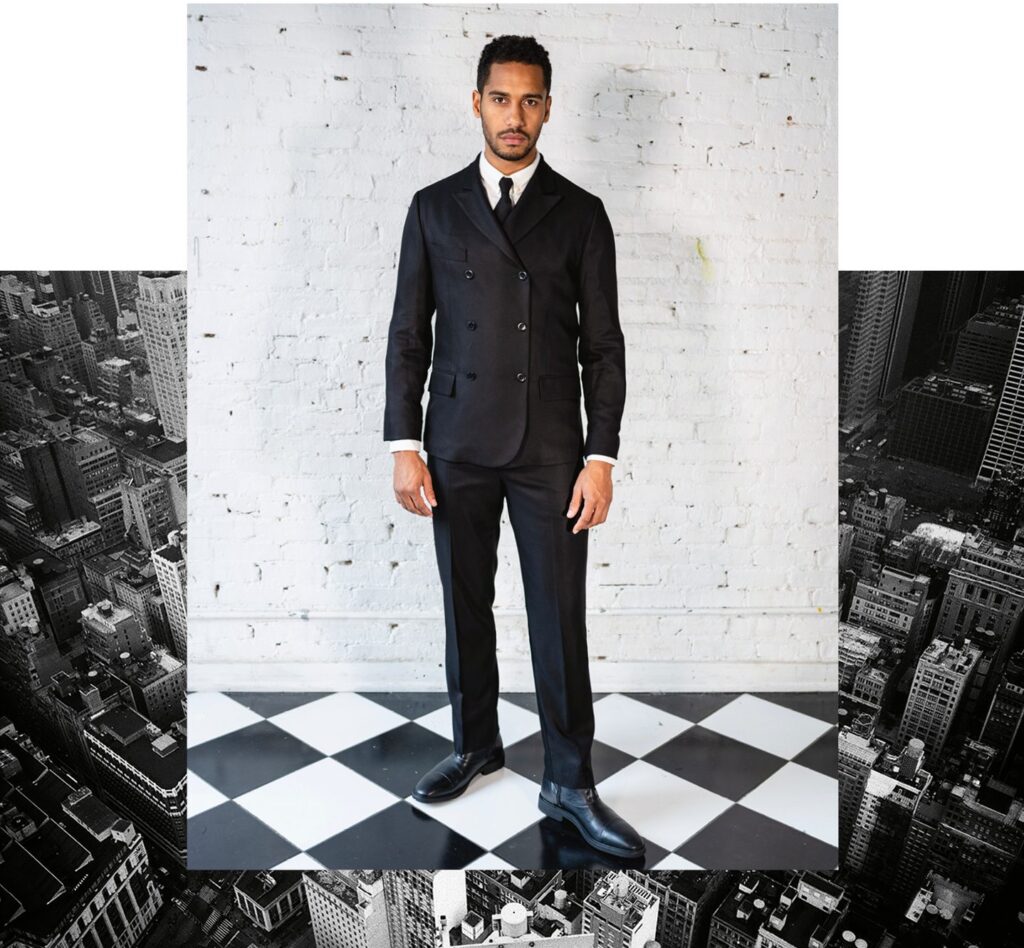
Two-Piece Brave GentleMan Classic Suit in navy, made to order from $3,600
Dressing for success does not ignore accessories, and it’s never been a better time to bring vegan leather into your wardrobe. Vegan leathers of today are made from a variety of plant-based materials, including cactus, apple, pineapple, and grape. The bag on your shoulder was the forefront of vegan fashion back in the day, and it’s still where much of the magic happens. Gone are the days of the leather-versus-pleather struggle: fashionistas today might choose a structured, sophisticated design from Alexandra K or complement neutrals in clothing with a colourful style from Ashoka Paris.
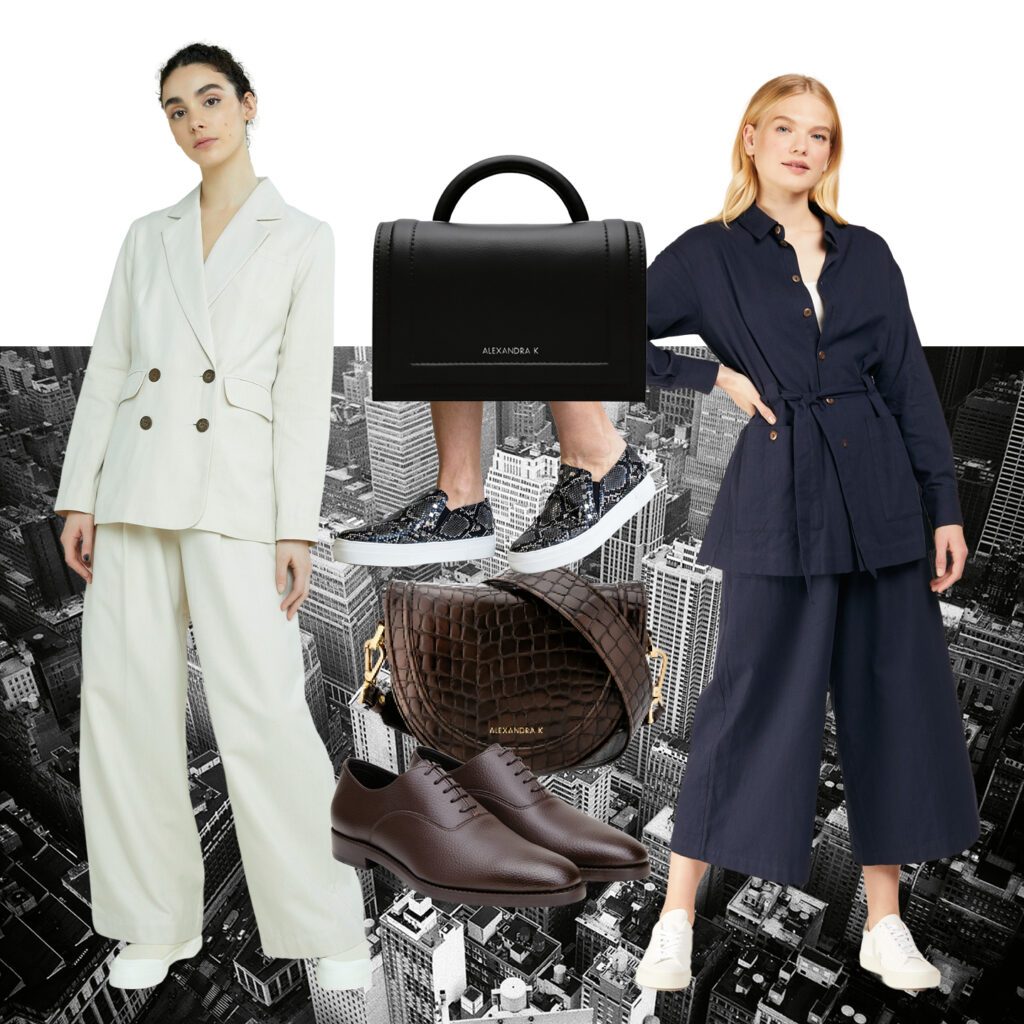
Left: People Tree, Flora Wide Leg Trousers in Natural, from $172 • Centre, from top: Alexandra K, Hope in Black Ink bag, from $409; Allkind Vegan, Hayley with Stud Detail in Black, from $116; Alexandra K, Joy Midi in Mokka Croco bag, from $424; Brave GentleMan, Executive in Espresso, from $410 • Right: People Tree, Shreya Jacket and Gianna Trousers in Navy, from $234 and $197
Usually, your choice of shoes for work will depend largely on your workplace and the type of work you do. Whether formal styles are required or not, you may still want to choose a smart-looking design. Australian brand Zette Shoes, which offers Fair Trade, handmade vegan footwear, is a great choice for everything from heels to ankle boots to Oxfords – they know their office footwear. Another option is Allkind, where you’ll find a range of pared-back, sleek styles that will create a perfect foundation for your look, while allowing the rest of your outfit do the talking.
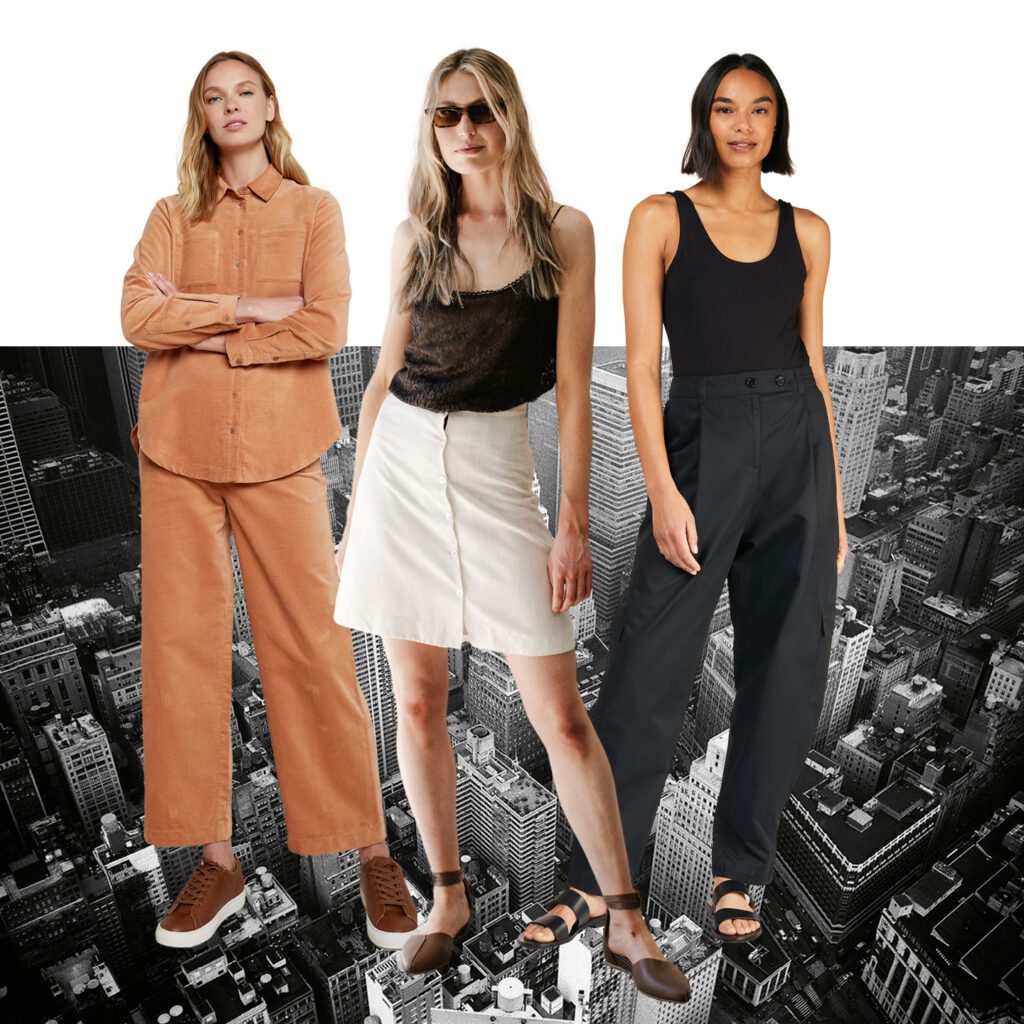
From left to right: People Tree, Amaira Velvet Shirt and Paula Velvet Trousers in Camel, from $49 and $52; Zette Shoes, Giselle Flat in Cognac, $179; People Tree, Alexandra Trousers in Black, from $154
Working from home is here to stay for many, and we aren’t suiting up for it. In this case, loungewear is your best friend. It’s not quite pyjamas, but just as comfy while still presenting well when on those video calls. From the softest organic cottons to recycled fibres that create a faux-cashmere feel, the market is overflowing with amazing home-office options.
***
If suiting up for success is your vibe, here’s what you need to know to make it cruelty-free.
You’ll need to avoid garments containing wool, mohair, angora, alpaca, and cashmere. Wool is the most frequently used material in business suits, so make sure you read the label. Instead, look for fabrics such as organic cotton, linen, and recycled materials. Some brands now use hemp too, often blended with other fibres.
Look out for linings that are made from silk. Rather, look for recycled synthetics, which are frequently used, as well as natural materials such as cupro (a silk-like fibre derived from a waste part of the cotton plant).
Buttons are most commonly made from plastic, but there are non-vegan varieties in horn, bone, and mother-of-pearl around that you’ll want to avoid. A great sustainable and cruelty-free option is corozo nut – a plant-based, natural, biodegradable material.
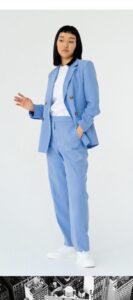
***
What do we do if our work uniform requires us to wear non-vegan items? Certain jobs make leather shoes a requirement, while some uniforms contain wool. Your best bet in this case is to raise the issue up with your manager and explore whether a vegan alternative may be available for you. There may also be others who feel the same way or are open to advocating for cruelty-free uniform options. If so, you may be able to create lasting change at your company, which would benefit animals and people alike.
Cover image: Zette Shoes, Lauren T-bar Mid-heel in Black, $169; People Tree, Jaspal Checked Jacket in Grey Check, from $81; Zette Shoes, Zari Block Heeled Sandal in Black, $179
Going vegan can be a life-changing experience, and it’s not without its challenges. The good news is you’re not alone. There are identifiable...
Time for an eco spring clean? Here are seven simple swaps for the conscious consumer
Mountains stretch down to coastal plains, which hug the curves of over 100 pristine beaches, all gazing out towards the stunning waters of the...
There’s a serum for every skin condition, but which active ingredients do what? This is the guide to vegan and sustainably sourced serums...
If you want to get your gut in order, Dr Will Bulsiewicz is the expert to help you sort out fact from fiction. This is the gut-health cheat sheet...
If you haven’t quite got your cycle phases figured out, you’re not alone. But it’s time to tune in to your body’s rhythms - so that you...
In the fast-paced and demanding world we live in, finding moments of stillness and calm can be challenging. In an attempt to find a little peace...
The trick to this super-vibrant green curry is to add a bunch of blitzed leafy greens into the paste to ensure a lovely, bright-green colour. I...
This salad is a take on urap sayur that instead uses crumbled tempeh and toasted almonds to top the dish. A balance of spicy, sweet, and sour...
Shifting to a wholefood plant-based diet doesn’t mean missing out on cheesecake. This recipe uses tofu instead of cream cheese and is therefore...
This Indonesian fried noodle dish can be found at both high-end restaurants and street food vendors in the region – it’s a popular dish for...
Spraying sheets and pillows with calming scents can be a wonderful aid to slumber
The next time you go for a walk, discover the wonder of the everyday world around you
A skincare routine can be a way to nourish yourself inside and out
When the clouds converge, practise gratitude for the smallest of glimmers, and learn to dance in the rain.
Whether you want to dazzle on date night or sparkle at a social gathering, these high-octane accessories will light up the night.
After-dark dressing is perhaps the most fun and indulgent part of building your wardrobe. It’s a time to put aside the boring basics and experiment with glitz, glamour, and perhaps a little excess.
Let’s consider some of the most powerful elements in the accessory armoury that can help you stand out in the crowd.
Elevate your look (quite literally) by adding a pair of patent stiletto pumps, such as those designed by Australian vegan shoe label Huntd.
Influencer-turned-designer Nadhisha Perera favours pared-back, easy-to-match colours such as black and beige, which will effortlessly pair with any colours you may have in your wardrobe. The sleek design makes these pumps the ideal all-day pair to take you from the office to the cocktail lounge.
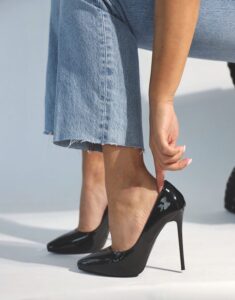
Huntd, Classic Point in patent black, $169
Vegan brand LaBante London create chic, structured designs that can be worn over the shoulder thanks to an elegant chain strap, making it perfect for the evening. This small yet attention-grabbing accessory will add a classy touch to a simple dress, slouchy blouse, or jeans-and-a-top combo.
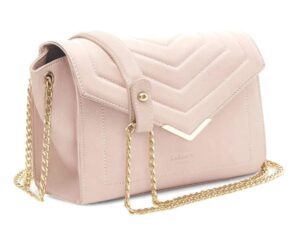
LaBante London, Kensington in nude, from $169
Nights can get chilly, and your outerwear needs some glamour too. And this doesn’t get any easier than simply throwing on one of Helen Moore’s faux-fur stoles.
Decadent, fluffy textures meet good-mood colours for an accessory that will not only add warmth but will also instantly glamourise your coat or jacket. All of this without as much as one hair off an animal’s head.
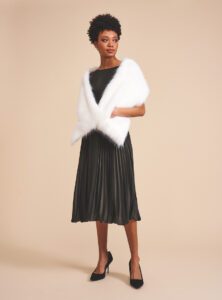
Helen Moore, Wedding Pocket Stole in whisper, from $216
Daytime glamour is not to be underestimated – and neither is a subtle, less in-your-face approach to accessories. A watch with a hint of shine, like Votch’s metal designs, will lend a polished finish to workwear or artfully dress up a weekend ensemble. Wear it with a three-quarter sleeve to give it the space and attention it deserves.
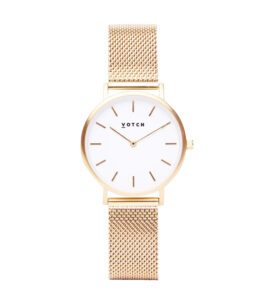
Votch, Mesh Petite in gold and gold, from $196
The ultimate in after-dark accessories is a shiny little clutch, often enough to raise the glam factor of an outfit on their own. LUXTRA make some beauties that are roomier than they look, with a high-shine design that will make you stand out for all the right reasons.
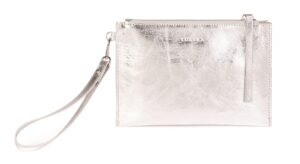
LUXTRA, The Junko in shiny silver, from $167
Dance the night away, stopping only to receive compliments for your stunning shoes. Serving up a broad range of leather-free designs since 2001, Beyond Skin are pioneers of the vegan shoe scene – and they sure know how to make a fancy heel. Whether you favour a block heel or a stiletto, there’s a shoe for you in their dazzling evening collection.
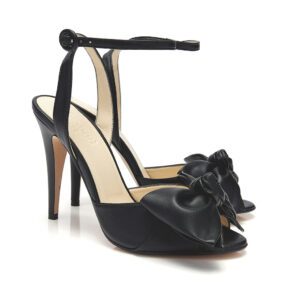
Beyond Skin, Alora, from $423
***
Whether you’re dazzling in sparkly metals, getting plushy in faux fur, or elevating your look with luxurious vegan leather, dressing glamorously when forgoing animal products has never been easier. Fashion can be so much more than functional; it can be fabulous and fun too!
Mountains stretch down to coastal plains, which hug the curves of over 100 pristine beaches, all gazing out towards the stunning waters of the...
If you want to get your gut in order, Dr Will Bulsiewicz is the expert to help you sort out fact from fiction. This is the gut-health cheat sheet...
There’s a serum for every skin condition, but which active ingredients do what? This is the guide to vegan and sustainably sourced serums...
If you haven’t quite got your cycle phases figured out, you’re not alone. But it’s time to tune in to your body’s rhythms - so that you...
Going vegan can be a life-changing experience, and it’s not without its challenges. The good news is you’re not alone. There are identifiable...
In the fast-paced and demanding world we live in, finding moments of stillness and calm can be challenging. In an attempt to find a little peace...
Time for an eco spring clean? Here are seven simple swaps for the conscious consumer
This salad is a take on urap sayur that instead uses crumbled tempeh and toasted almonds to top the dish. A balance of spicy, sweet, and sour...
The trick to this super-vibrant green curry is to add a bunch of blitzed leafy greens into the paste to ensure a lovely, bright-green colour. I...
This Indonesian fried noodle dish can be found at both high-end restaurants and street food vendors in the region – it’s a popular dish for...
Shifting to a wholefood plant-based diet doesn’t mean missing out on cheesecake. This recipe uses tofu instead of cream cheese and is therefore...
Spraying sheets and pillows with calming scents can be a wonderful aid to slumber
The next time you go for a walk, discover the wonder of the everyday world around you
A skincare routine can be a way to nourish yourself inside and out
When the clouds converge, practise gratitude for the smallest of glimmers, and learn to dance in the rain.
Don’t be a fast-fashion victim, be your own sustainable-style star.
In a world where the equivalent of a garbage truck of textiles is burned or thrown into landfill every second of every day, ‘fast fashion’ has become a dirty word. But what about fast fashion makes it fast?
Constantly churning out new items, some fast-fashion chains launch as many as 50 new collections every year. This ever-spinning wheel of overproduction is closely linked to the issues connected to fast fashion: the devastatingly low salaries of garment workers, the horrifying conditions they work in, and the vast environmental destruction of it all.
Slow fashion was born as an antidote to this. It’s a movement that aims to halt the spinning wheel and bring a more mindful attitude into fashion. Elements of slow fashion may include an attention to workers’ salaries and working conditions as well as environmental concerns, but at the core of the concept lies an endeavour to slow down the cycle of overproduction and the associated textile waste. In doing this, supporters of slow fashion argue, the industry would also address many issues that make the fashion trade problematic.
The term was first used by research professor at the Centre for Sustainable Fashion Kate Fletcher, who defines slow fashion as based on quality rather on speed. To reframe our mindset around fashion would mean an uncoupling from the conditioned ‘need’ to constantly obtain new clothing and then get rid of it as soon as a new season comes around.
Stylist and slow-fashion advocate Meg Pirie says, “As a slow-fashion activist, I see the movement as a collective effort to move away from the traditional and wasteful linear model and towards alternative systems.” One of these alternative systems is circular fashion, which avoids the linear flow of resources where they are used and then discarded, in favour of a new way of working where reuse is preferred. This method means that resources are used again and again – recycled, reimagined, and kept in circulation.
Circular fashion is seen as a ‘slower’ model than current systems because it minimises waste. One example is the production of Lyocell (or Tencel, as it’s also known), a vegan-friendly material made from wood-pulp cellulose. This textile is produced using a ‘closed loop’ technology, where the water and chemicals used in the production process are reused. By prioritising planet-friendly production practices, this material sets a sustainable standard for the fashion world to follow.
“Slow fashion embodies a more mindful approach, from slow design through to taking the time to make consumerism more gradual,” explains Meg. She says that the reasons to switch to slow fashion are many, and that action must be taken quickly. “The anthropogenic changes to the planet we’re witnessing are highly unsettling and we need drastic change to keep well within the 1.5°C threshold urged by scientists.”
Meg is referring to the expected rise in global warming, which is already soaring. Recent reports on climate change confirm the likelihood that the average temperature on Earth will hit 1.5°C degrees of warming in the next few years. Because fashion has been named many times as one of the most polluting industries in the world – largely because of its toxic practices, enormous amount of waste, and high volumes of production – it’s crucial that the industry does its part and takes the compulsory steps needed to lower its impact.
However, slowing down the fashion machine is an area where we as consumers have significant impact. Simply shifting our mindsets around what we wear and why we shop the way that we do can lead the way for important changes. For fashion to be truly ethical, it must be slow fashion. Choosing slow-fashion brands is a start because, unlike most fashion companies, they will not produce a new collection every season, or even every year. Rather, they will have a core offering of timeless garments and occasionally add more designs to this.
Getting more creative with your wardrobe and learning to love the clothes you already have is another step towards lowering your consumption footprint. Taking care of your clothes is yet another – as part of her slow-fashion advocacy, Meg runs mending workshops where she teaches participants to prolong the lifespan of their garments.
Lastly, finding your personal style can go a long way towards avoiding impulse shopping. Knowing who you are fashion-wise and what suits you means that you’ll be less likely to succumb to trends or follow passing fads. The added bonus is that this also guarantees you feel amazing in your clothes – arguably the entire point of fashion.
Make a Pinterest board where you save the looks that you love, then analyse these. Can you see a pattern emerging? Certain types of garments that are commonly recurring? Colours? Moods? These are the foundations of your personal style.
It’s time to analyse the contents of your wardrobe, clearing out what doesn’t work for you. Pay attention to the items that go straight into the ‘keep’ pile. Why do you love them? What is it about them that has you wearing them again and again? Keep these garments and build your personal style around them.
Now for the flipside. During your clear-out, note the garments that you never wear and those that ended up in the ‘donate’ pile. Do these items have any traits in common? If they’re all brightly coloured, for example, maybe vivid hues aren’t your thing.
Following a guide for finding your personal style can bring a lot of insight. A great book you might refer to is The Curated Closet by Anuschka Rees. This manual walks you through the process of finding your style one step at a time, from analysing what’s already in your wardrobe to shopping for additional pieces.
Build your personal style on long-lasting, timeless elements that will remain true to who you are for a long time to come. Passing fads may be fun, but they’re also fleeting and often fast fashion. Items that are closely tied to specific trends generally aren’t good investments when it comes to your wallet and wardrobe or for the planet.
If you want to get your gut in order, Dr Will Bulsiewicz is the expert to help you sort out fact from fiction. This is the gut-health cheat sheet...
Mountains stretch down to coastal plains, which hug the curves of over 100 pristine beaches, all gazing out towards the stunning waters of the...
In the fast-paced and demanding world we live in, finding moments of stillness and calm can be challenging. In an attempt to find a little peace...
Eco period products have risen in popularity – they’re sustainable, affordable, healthy, and convenient. Here’s what you need to know so...
If you haven’t quite got your cycle phases figured out, you’re not alone. But it’s time to tune in to your body’s rhythms - so that you...
Going vegan can be a life-changing experience, and it’s not without its challenges. The good news is you’re not alone. There are identifiable...
There’s a serum for every skin condition, but which active ingredients do what? This is the guide to vegan and sustainably sourced serums...
Shifting to a wholefood plant-based diet doesn’t mean missing out on cheesecake. This recipe uses tofu instead of cream cheese and is therefore...
This salad is a take on urap sayur that instead uses crumbled tempeh and toasted almonds to top the dish. A balance of spicy, sweet, and sour...
This Indonesian fried noodle dish can be found at both high-end restaurants and street food vendors in the region – it’s a popular dish for...
The trick to this super-vibrant green curry is to add a bunch of blitzed leafy greens into the paste to ensure a lovely, bright-green colour. I...
Spraying sheets and pillows with calming scents can be a wonderful aid to slumber
The next time you go for a walk, discover the wonder of the everyday world around you
A skincare routine can be a way to nourish yourself inside and out
When the clouds converge, practise gratitude for the smallest of glimmers, and learn to dance in the rain.
Our love of fashion along with unsustainable industry practices contributes to the climate crisis. Here’s how to make your love of fashion more ethical.
Our current climate emergency requires industries around the world to act now, and the fashion industry needs to face the fact that it is one the biggest contributors to pollution and climate breakdown. At the same time, the way we consume clothing is a factor in this crisis. If we want to reduce our impact, we need to reframe the way we view fashion. How we respond to the constant stream of new collections and trends that change every couple of months can be destructive to humans, animals and our planet.
And I’m not just talking about conscious shopping. I’m talking about contacting your favourite brands and requesting more vegan options, asking your favourite fashion influencer to feature cruelty-free beauty, or petitioning local shops to stop selling fur. We have the power to effect change on more than just a personal level.
Many brands have sold faux-leather shoes for years, but now they are marketing them as vegan. This is a testament to how interest for vegan living has grown and evolved. And I believe this is a positive step. Of course, the way many of these brands operate is not ideal on many levels, and we shouldn’t assume their production practices are 100 per cent ethical just because they have a vegan range. This is where our own judgement needs to come into play.
We need to be aware that greenwashing is a marketing strategy for many brands. For example, there is a huge problem with the claim that leather is an eco-friendly choice. Data from the Higg Materials Sustainability Index identifies cow leather as the most environmentally harmful material per kilogram in terms of cradle-to-gate impact (the product life cycle before it is transported to the consumer) – rating far worse than synthetic options, which can also be very harmful to the planet.
The Kering Environmental Profit and Loss Report found 93 percent of leather’s damage to the planet occurs before the tannery stage, due to the environmental cost of raising animals. Beyond this stage, 90 percent of all leather workers in Bangladesh, many of whom are children, die before they are 50 due to exposure to toxic chemicals in the tanning process. And ‘vegetable tanned’ leather doesn’t solve this issue.
Fortunately, it’s outdated to think our only choice is between animal skin and petroleum-based ‘pleather’, both of which have their problems. These days we have plenty of plastic-free options, such as pineapple leather, apple leather, wine leather, mushroom leather, and cork – which isn’t even a new material; it’s been around for ages. With the likes of Hugo Boss releasing pineapple leather shoes and MIMCO creating an award-winning apple peel leather collection, it’s clear that ethical alternatives are hitting the mainstream. Perhaps even more exciting are the innovations that are still under development, like lab-grown leather. Once these become commercial, I believe it will make animal skins completely obsolete.
I predict vegan wool will be the next big thing. Many people are unaware of the cruelty behind the wool industry. Sheep are bred to produce much more wool than they would naturally need, and countless undercover investigations have shown inhumane treatment of sheep during the shearing process. Environmentally, sheep farming contributes to deforestation, desertification and topsoil loss, as well as producing huge quantities of methane gas. Just as with leather, our choices aren’t just between wool or plastic. More sustainable fabrics like Tencel (wood cellulose), hemp, soybean fabric and organic cotton are great wool alternatives. Plus there are some new innovations, including Woocoa, a vegan wool made from coconut and hemp and Nullarbor, an innovation by Australian brand Nanolloose, which uses coconut waste to create a vegan wool-like fabric.
A great way to elevate your ethical fashion cred is to follow influencers and brands who focus on sustainable vegan clothing. In recent years, smaller ethical labels have also started paying more attention to design, resulting in beautiful vegan fashion options, something that we didn’t always have. These brands are the heroes of the movement in my opinion – the owners of these companies really pour their hearts and souls into making a change and creating durable, viable ethical alternatives.
I am also a huge proponent of second-hand clothes. This is the most ethical way to shop, and offers options for every budget. You can have great fun discovering options on eBay and via second-hand fashion apps, such as Depop. I only buy vegan-friendly items and I always find what I’m looking for and more. Get lost in the world of online second-hand shopping (it’s a game-changer!).
There has never been a better time to learn more about ethical fashion, and be part of the change. Get in touch with your favourite brands and ask for examples of what they are doing to make the fashion world a kinder place. And not just stances – actual examples. It’s easy to say, “We believe that animals and humans should be treated well”. We want answers to questions such as: Have you stopped selling animal fur? Are you offering vegan-friendly fashion options? Can you tell me where the clothing was made, and how much the people who made it were paid? Asking brands these questions sends a powerful message that consumers care about ethics.
Most of all, find your personal style! I believe in creating a durable, versatile wardrobe that you love, that doesn’t necessarily follow trends. We need to shift our focus from trends to personal style – so, understand who you are, and communicate this with a sense of style that transcends the seasons.
Time for an eco spring clean? Here are seven simple swaps for the conscious consumer
Going vegan can be a life-changing experience, and it’s not without its challenges. The good news is you’re not alone. There are identifiable...
If you haven’t quite got your cycle phases figured out, you’re not alone. But it’s time to tune in to your body’s rhythms - so that you...
Eco period products have risen in popularity – they’re sustainable, affordable, healthy, and convenient. Here’s what you need to know so...
There’s a serum for every skin condition, but which active ingredients do what? This is the guide to vegan and sustainably sourced serums...
In the fast-paced and demanding world we live in, finding moments of stillness and calm can be challenging. In an attempt to find a little peace...
Mountains stretch down to coastal plains, which hug the curves of over 100 pristine beaches, all gazing out towards the stunning waters of the...
The trick to this super-vibrant green curry is to add a bunch of blitzed leafy greens into the paste to ensure a lovely, bright-green colour. I...
Shifting to a wholefood plant-based diet doesn’t mean missing out on cheesecake. This recipe uses tofu instead of cream cheese and is therefore...
This Indonesian fried noodle dish can be found at both high-end restaurants and street food vendors in the region – it’s a popular dish for...
This salad is a take on urap sayur that instead uses crumbled tempeh and toasted almonds to top the dish. A balance of spicy, sweet, and sour...
Spraying sheets and pillows with calming scents can be a wonderful aid to slumber
The next time you go for a walk, discover the wonder of the everyday world around you
A skincare routine can be a way to nourish yourself inside and out
When the clouds converge, practise gratitude for the smallest of glimmers, and learn to dance in the rain.
Sashay through summer with style and sustainability. The fabric of your frock is where it’s at these days, as we say so long to the cruelty of silk and take a hard pass on toxic polyester.
One of the best things about the warmer months has to be sashaying about in a summer dress. Not only are they the simplest one-piece solution to the age-old what-should-I-wear conundrum, but they are also comfortable, flattering, and timeless. They are appropriate for all occasions, from the beach to the boardroom and are largely free from problematic materials, such as wool, leather, or fur. While there are still a few fabrics to forgo, there are plenty of alternatives that are stylish and superior.
Few people are aware of the cruelty behind silk – it’s made by boiling the cocoons that silkworms live in before they become a butterfly. The little worms are often boiled alive in the process, and just one kilogram of silk can cost the lives of 6,600 silkworms. Aside from the cruelty to animals, silk is also considered a hazard to the environment. The Higg Material Sustainability Index has placed it at the top of its list of textiles with the worst environmental impact, from raw fibre production to finished fabric. The big culprit here is its use of fossil fuels and the associated global warming potential, which has driven many to shun silk. But when we refuse silk, its replacement must be chosen carefully.
When avoiding silk, the most common replacement for a floaty dress might be one made with cheap polyester – a flowing, sheer, versatile fabric that can perfectly mimic the qualities of silk. But considering its impact on the planet, conscious consumers may want to steer clear. Polyester, just like its cousins nylon and acrylic, comes from petroleum-based fibres, which involve many toxic chemicals in their production. The process itself also puts a hefty strain on our environment. If that were not enough, polyester also fails to biodegrade when discarded. In short, not the most modern or discerning choice.
As we become more conscious consumers, we not only eschew problematic fabrics, we also actively seek out more fashionable fabrics of choice. It helps to know what you’re looking for here because cheap and nasty polyester is extremely common – found in approximately 60 percent of all garments available in retail today. Here are a few of our favourite fabrics to look for when seeking out your next summer dress.
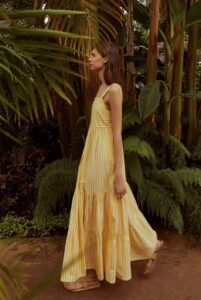
One of the most common materials in sustainable fashion, organic cotton uses considerably less water and fewer pesticides than conventional cotton. It is frequently used in dresses that are well suited for day wear. People Tree – a legendary name in the ethical fashion world – offers a range of summer dresses in cleaner version of a classic fabric.
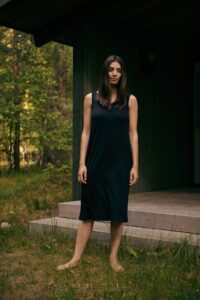
Made from wood pulp cellulose, TENCEL is an innovative material that is gaining ground in eco-fashion circles. It is made with a closed-loop technology, meaning that the water and chemicals used in the process are reused to minimise waste. The fabric is soft, comfortable, breathable, and, best of all, doesn’t wrinkle easily. Find a TENCEL dress at Organic Basics, a brand focused on transparency and considered materials of choice – their pared-back essentials can form the backbone of a sustainable capsule wardrobe.
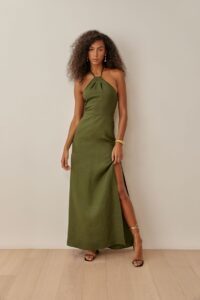
Linen is a natural, biodegradable material that boasts strength and resistance among its many qualities. It’s also versatile, lending itself perfectly to a lightweight mini dress as well as a more statement-making maxi piece. Among the brands offering head-turning linen designs is Reformation, the sustainable label known for its dresses.
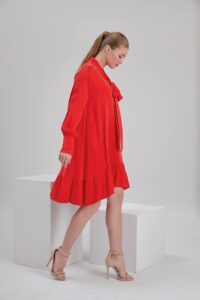
This soft and silky material is a by-product of the cotton plant, making it an excellent alternative to silk. It comes from linter, a part of the plant that is not involved in the making of cotton fabric. Companies such as Dutch sustainable fashion brand NOACODE work with this part of the plant to create a cellulose fabric that is kind to the environment and simply perfect for summer dresses.
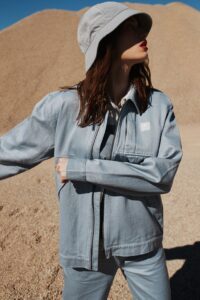
Perhaps the most sustainable fabric in the fashion industry, hemp grows without any need for pesticides or chemical fertilisers, making it perfect for organic farming. It also requires much less land and water than cotton while offering similar fabric characteristics. Don’t be fooled into thinking it’s a fabric solely for the hippie types, brands using hemp are putting style at the forefront of their mission. Among these is Afends, the Byron Bay label that’s gained global recognition for its street-meets-coast aesthetic and commitment to sustainability.

A little-known fabric in the world of sustainable fashion, ramie comes from the stalks of a flowering plant in the nettle family. It holds its shape and presents a naturally wrinkle-free texture. Ramie also absorbs dye easily, making for versatile design. London-based slow-fashion brand lu-ciee focuses on empowering artisans in Bali, where its designs are made. Their effortlessly chic styles in ramie are the perfect example of an alluring antidote to fast fashion.

This is one for the zero-wasters! The garment-making process is notoriously wasteful – the equivalent of one garbage truck full of textiles is burned or placed in landfill every second. This is one of the reasons why deadstock, or leftover materials, is rising in popularity among eco-conscious fashion companies. Portugal-based label Stay Golden Couture works with sustainable fabrics such as linen and TENCEL, but this recently launched company also offers beautifully cut dresses in deadstock fabric, making the garments zero-waste.
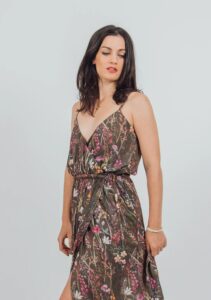
Remember polyester, the villain from before? Well, in the right conditions, it can become somewhat less villainous. Recycling may not single-handedly save the world, but it does offer a second lease of life to materials that would otherwise have ended up in landfill. Sustainably minded fashion companies frequently choose recycled polyester over its virgin counterpart. One example is Danish-British designer Ulla Vitting Richards, who founded eco-fashion label VILDNIS with the aim to inspire change – and by offering designs made from recycled materials, the brand is doing just that.
If you haven’t quite got your cycle phases figured out, you’re not alone. But it’s time to tune in to your body’s rhythms - so that you...
Going vegan can be a life-changing experience, and it’s not without its challenges. The good news is you’re not alone. There are identifiable...
Time for an eco spring clean? Here are seven simple swaps for the conscious consumer
Mountains stretch down to coastal plains, which hug the curves of over 100 pristine beaches, all gazing out towards the stunning waters of the...
There’s a serum for every skin condition, but which active ingredients do what? This is the guide to vegan and sustainably sourced serums...
In the fast-paced and demanding world we live in, finding moments of stillness and calm can be challenging. In an attempt to find a little peace...
Eco period products have risen in popularity – they’re sustainable, affordable, healthy, and convenient. Here’s what you need to know so...
The trick to this super-vibrant green curry is to add a bunch of blitzed leafy greens into the paste to ensure a lovely, bright-green colour. I...
Shifting to a wholefood plant-based diet doesn’t mean missing out on cheesecake. This recipe uses tofu instead of cream cheese and is therefore...
This salad is a take on urap sayur that instead uses crumbled tempeh and toasted almonds to top the dish. A balance of spicy, sweet, and sour...
This Indonesian fried noodle dish can be found at both high-end restaurants and street food vendors in the region – it’s a popular dish for...
Spraying sheets and pillows with calming scents can be a wonderful aid to slumber
The next time you go for a walk, discover the wonder of the everyday world around you
A skincare routine can be a way to nourish yourself inside and out
When the clouds converge, practise gratitude for the smallest of glimmers, and learn to dance in the rain.